 Are you looking for rich and insightful blog posts to boost your social media marketing?
Are you looking for rich and insightful blog posts to boost your social media marketing?
We asked our writers to share their favorite social media blog posts.
What follows is a gold mine of content you can apply to your marketing in 2014.
#1: Enlarge Your Digital Footprint for More Effective Online Marketing

I love this post by Barry Feldman because it emphasizes content promotion (which is all-important) and includes a comprehensive list of specific actions.
It's a great overview for beginners. But the pros may also find a few tactics they aren't using.
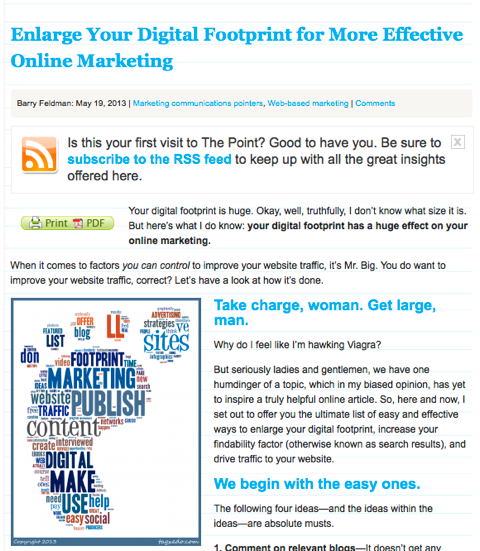
It's a great piece of writing. As usual, Barry is approachable and direct. Not a word is wasted. It's one of the great posts of 2013 for both style and substance.
Andy Crestodina, strategic director of Orbit Media.
#2: A Visual Guide to Keyword Targeting and On-Page Optimization

With of all last year's changes in the social media space, there are so many articles to choose from! But one article that resonated with me was Rand Fishkin's A Visual Guide to Keyword Targeting and On-Page Optimization.
Every blogger knows that it's important to optimize their pages properly, but it's hard to keep track of everything you need to do with on-page optimization.
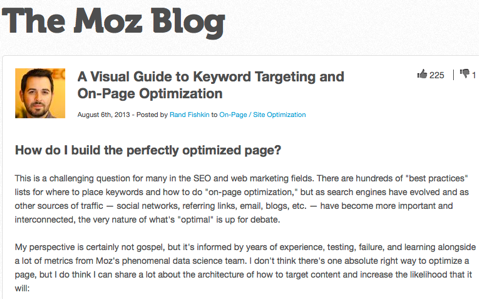
In this article, Rand clearly lays out the most important parts of on-page optimization. He uses an infographic and also gives details with visual examples to explain his points. Though some of the points are high-level and complex, he breaks them down so they're easy for beginners—as well as advanced SEO professionals—to understand.
Rachel Sprung, product marketing associate at HubSpot.
#3: Tell Your Business Story, One Blog at a Time

Back in April, I came across Mike Alton's article, Tell Your Business Story, One Blog at a Time. As someone drawn to the idea of storytelling, I love the way Mike approaches the subject matter, practicing what he preaches by telling a compelling story about storytelling.
Sure, the connection between storytelling and business blogging has been made before, but what differentiates this article from others for me is:
Get World-Class Marketing Training — All Year Long!
Are you facing doubt, uncertainty, or overwhelm? The Social Media Marketing Society can help.
Each month, you’ll receive training from trusted marketing experts, covering everything from AI to organic social marketing. When you join, you’ll also get immediate access to:
- A library of 100+ marketing trainings
- A community of like-minded marketers
- Monthly online community meetups
- Relevant news and trends updates
- A great lead-in photo of Tom Hanks from the movie Apollo 13 (never underestimate the power of images!)
- Quotes from a few other stand-out movies and how those lines “touched us and taught us something…and we remember them to this day.” For example, “Toto, I've got a feeling we're not in Kansas anymore.”
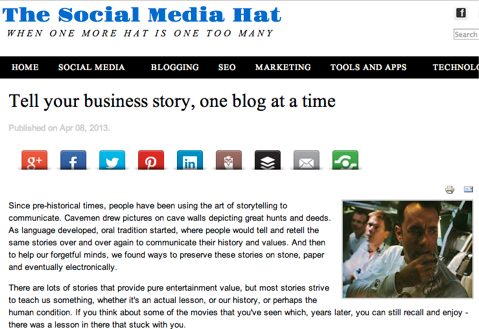
Mike suggests that storytelling is one of the most effective purposes of a business blog. He outlines six different kinds of stories businesses can tell:
- How you got started
- How you work
- Teach with a lesson—using rich, authentic stories
- Communicate vision
- Demonstrate values
- Overcome objections
As storytellers, Mike reminds us to be genuine, paint a picture with words, bring the audience into the story and keep them in mind. All highly valuable points to take with us as we write our way into 2014!
Debbie Hemley, freelance writer and social media coach.
#4: Is Youtility the Future of Marketing?

My favorite post of 2013 is Jay Baer's Is Youtility the Future of Marketing?
It's becoming increasingly difficult to get the attention of a prospective customer. At the top of the sales funnel (i.e., when the potential customer makes first contact with you), Jay outlines three ways of getting attention:
- Top of mind awareness
- Frame of mind awareness
- Friend of mine awareness
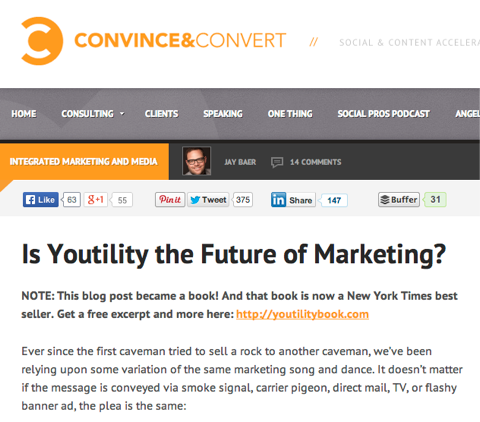
Top of mind awareness is an expensive marketing technique that uses constant marketing, so when the person is ready to buy they will think of you. Frame of mind awareness is also called inbound marketing. This is where you produce content that helps you get found through search or on social channels, so when a potential customer is looking for your product or service, they are attracted with content and converted over time.
Jay also talks about a third option that he calls friend of mine awareness. This is where you provide something of real value to the customer. For example, you build an app that provides a useful service. It may be expensive to build the app, but it's so useful that prospects become attached to the brand. They view the brand differently because your app adds real value. Jay calls this Youtility.
What I really like about the post is that it shows a new direction for marketing. We can all provide “Youtility” to our potential customers and stand out from the crowd. Jay's book, Youtility, provides all you need to know about this new form of marketing.
Ian Cleary, founder of RazorSocial.
#5: 6 Facebook Reporting Tools for In-Depth Analysis of Fan Pages

This is one of those posts where every single word is important and educational. In other words: I actually read the whole thing!
What I love most is that it speaks to a more advanced Facebook marketing audience and digs deep into how to analyze a Facebook page.

Many businesses are on Facebook just to be on Facebook, but there are plenty of tools that can show the impact of the social network. Kristi Hines explains them here, showing admins how they can demonstrate to bosses and colleagues the results they're getting. Plus it has a lot of pictures and I love articles with pictures!
I'd heard of all six tools mentioned in this post, Simply Measured, Socialbakers, Sprout Social, Rival IQ, Cyfe and Google Analytics, but I didn't know just how valuable each tool could be. This post really breaks down the offers, options, features and benefits of each tool so you can choose which one(s) will work best for your business.
Jim Belosic, CEO of ShortStack.
#6: How to Grow a Billion-Dollar B2B Growth Engine

The most valuable blog post I read in 2013 was HubSpot—How to Grow a Billion-Dollar B2B Growth Engine. HubSpot is known for championing the push toward inbound marketing and has long been great at using content marketing to drive leads. However, there has never been a good case study on how they've done it and what led to their success.
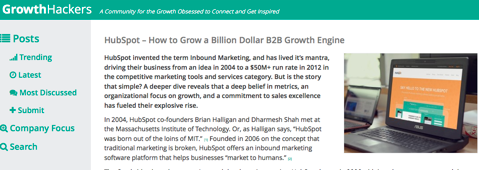
I really enjoy blog posts that are backed by data and use specific examples because they allow me to start thinking about new ideas. These posts also serve as motivation for me as an entrepreneur.
From early traction to taking risks on different tool sets to hosting webinars to creating a partnership program, there's enough in here to spark at least one actionable idea.
Eric Siu, founder of Growth Everywhere and COO at Single Grain, a digital marketing agency.
#7: 13 Characteristics of Human Brands

If I narrow down to one social media article that really shaped and guided me in 2013, it was this blog post by Pam Moore the Marketing Nut: “13 Characteristics of Human Brands.”
It was like getting a bucket of cold water splashed in my face!
It wasn't a strategy post. It was about the philosophy of life and business—not a “how-to” post, rather a “who are you?” post. It caused me to think long and hard about the core values, guiding principles and “human side” of our business.

I loved this post because it spoke to the heart of social media for business! Social media is SOCIAL—it's about people and relationships. It's person to person, not object to object or transaction to transaction.
Pam wrote passionately about this, cutting through the fluff, getting past all the data-mining and formulas and making a simple, clear point: It's about being real, authentic and human. That's the core of social media for any business.
Mike Gingerich, co-founder of TabSite.
#8: 11 Content Marketing Lessons Learned From 20 of the Top 100 Blogs

Neil Patel's blog is a must-read for content marketers and SEO professionals because he goes straight to the point and values the power of data over gut feeling.
These 11 tips are instrumental to growing a professional blog's audience. I had to learn them on my own when I started working on Nitrogram's content strategy, and now they all sit together on this list!
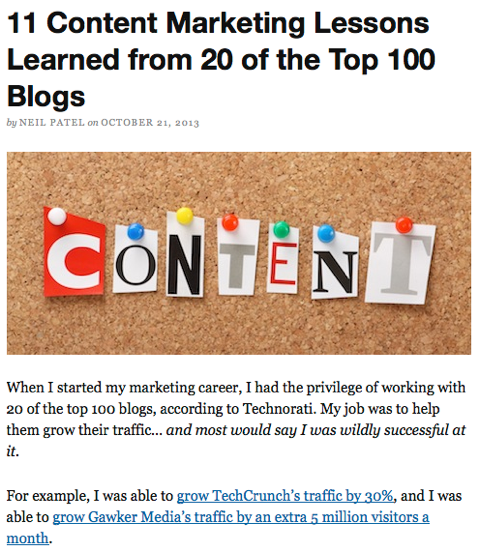
Following these tips will not only help you become a better writer and improve the impact of your own efforts, but will also improve your productivity. You'll get more done by outsourcing efficiently.
If you have to choose just one paragraph, make it “It's all about the headline.” I read it often. Should you focus on your blog post's body? Sure you should; that's what brings value to your readers. But what's a strong article worth if no one clicks your headline?
Thibaut Davoult, head of content marketing at Nitrogram.
#9: The Top 7 Social Media Marketing Trends That Will Dominate 2014

One of the most valuable posts I read this year about social media was The Top 7 Social Media Marketing Trends That Will Dominate 2014 by Jayson DeMers.
I found this post valuable because it clearly identifies many of the social media marketing developments that are important for brands and small businesses in the coming year.
Yearly roundup posts are often filled with fluff, but Jayson's post touches on actionable trends that business owners and marketers must take note of if they want to remain relevant in the ever-changing marketplace.
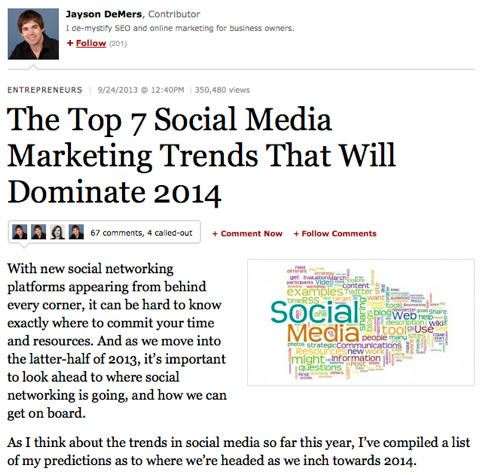
I learned about the continuing importance of Google+ and Google authorship, further stressing how companies need to focus on content to make an impact across their digital properties. Google is merely aligning with companies that are creating quality content, which Jayson helped outline nicely.
Brian Honigman, freelance writer and content marketing consultant.
#10: Social Media Stardom: 7 Lessons Marketers Can Learn From Digitally Savvy Celebrities

One of my favorite posts of the past year comes from Ekaterina Walter, who shared Social Media Stardom: 7 Lessons Marketers Can Learn From Digitally Savvy Celebrities.
The overarching theme is to focus on your audience and not yourself. This is a powerful lesson for any organization engaging on social media.
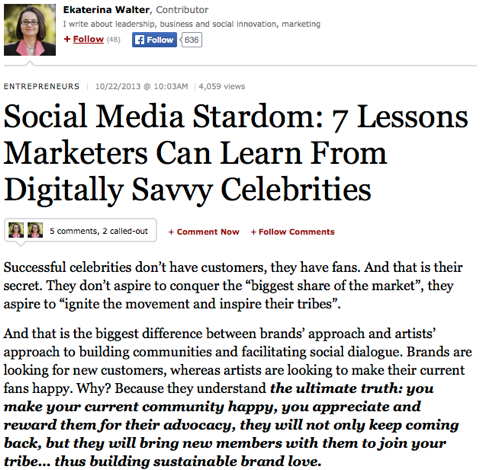
I really like the concept of building a tribe of brand advocates as a classic quality-over-quantity strategy, with the upside being that in social circles, quality can actually beget larger quantity as the hardcore fans are likely to be your biggest influencers.
Ben Pickering, digital marketing executive who has worked with many of the world's top brands.
#11: 9 Persuasion Lessons From a 4-Year-Old

As marketers and adults, we typically overcomplicate things. Not because we want to sound smart (all of the time), but because we usually don't get into our customers' heads during the content-creation process.
The article 9 Persuasion Lessons From a 4-Year-Old not only gives us 9 valuable tips we can use today, but also a perspective that brings us back to our own youth, when things were much more simple. Bringing out your inner child while writing can offer great results for your audience.
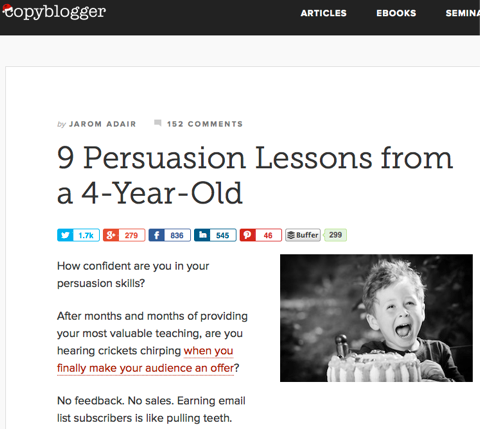
I learned that after I write or record anything, I need to review the content as if I were my own customer reading it AND make sure it's simple enough that a child would know what I'm asking them to do.
Greg Hickman, founder of Mobile Mixed.
#12: Twitter Files for IPO—What it Means for Users, Investors and Social Media

Without a doubt, the biggest social media event of the year was Twitter going public, which had a big effect on social media marketers on both short- and long-term fronts.
Brian Solis wrote a great piece for marketers about the IPO's impact on media, society and business, “Twitter Files for IPO—What it Means for Users, Investors, and Social Media.”
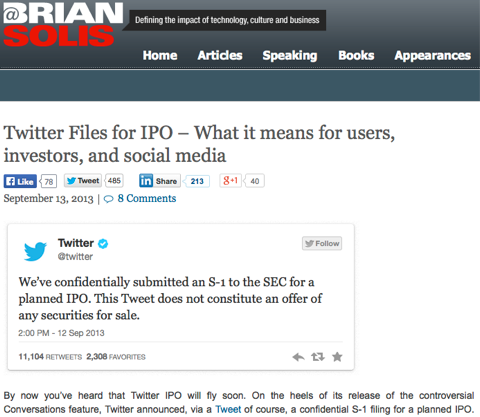
The post helped me understand the business effects the IPO will have on the network. Advertising on Twitter will become more viable for the company, and therefore more valuable for marketers as well.
As Twitter accumulates more data and the network grows, the platform becomes more approachable by both big brands and small businesses.
As for what's next, Twitter is committed to improving mobile engagement and mobile ads, with relevant acquisitions such as MoPub. As a public company, Twitter's business decisions will strike a unique balance between monetization and user experience.
Lior Degani, co-founder of Swayy.
#13: What Everybody Missed About Hummingbird: Social Signals

One of the most valuable blog posts I've read this year is Eric Enge's What Everybody Missed About Hummingbird: Social Signals, as it pertains to the implications of search and social.
This article expands on how in the past Google has had technical issues that impacted social signals as a ranking factor.
Enge highlights a recent study that showcased how Google+ share links hadn't actually impacted ranking in the past, indicating that while historically links have been a driver in SEO, social signals will become more prominent.
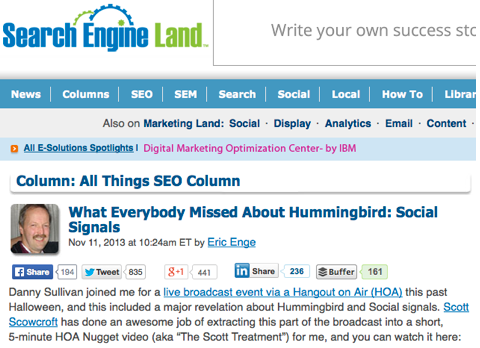
This piece illustrates how experts who specialize in particular topics should and can be recognized based on their online credibility.
While this post is relatively straightforward, it endorses the notion that social will inform search to a higher degree in the future and that to rank in Google, you must build social media credibility.
Stephanie Shkolnik, director of social media at Digitaria.
#14: How to Sell on Facebook: A Detailed, 9-Step Guide

For business value, I would recommend Jon Loomer's How to Sell on Facebook: A Detailed, 9-Step Guide.
Jon's practical step-by-step guide compiles tactical details on how to create highly targeted Facebook ad campaigns that ultimately result in sales conversions.
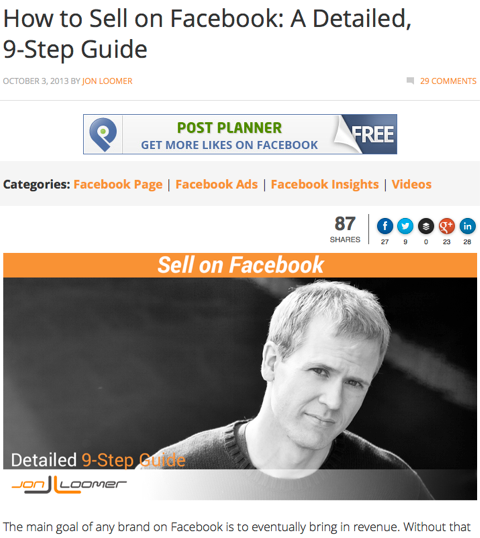
I loved the article for Loomer's insightful strategies such as:
- Setting up conversion pixels to track results
- Creating unpublished posts (to a/b or multivariate test)
- Targeting by email, lookalike and connection
- Tracking and optimizing your ads
I loved it even more because it walks you through the process with clear language and easy-to-understand screenshots.
Facebook ads have proven to be an effective way to reach our market, so knowing how to use the tools (with strategic tips) has been very valuable.
Krista Bunskoek, content marketer at Wishpond.
#15: This So-Called Digital Life: Re-Evaluating the Value of Time Spent in Social Networks

This post by Brian Solis really captures the other side of social media—the side that isn't often talked about, but is still very important to keep a handle on.
While this article really looks at how our teens are using social media and how it influences them, some of us older folks are feeling just the same way.

It can affect us all like a shot of dopamine (a neurotransmitter that helps control the brain's reward and pleasure centers). Each time we post something and get a reaction such as a like—or better still, a comment—it gives us pleasure. So we do it again and again and again.

Discover Proven Marketing Strategies and Tips
Want to go even deeper with your marketing? Check out the Social Media Marketing Podcast! Publishing weekly since 2012, the Social Media Marketing Podcast helps you navigate the constantly changing marketing jungle, with expert interviews from marketing pros.
But don’t let the name fool you. This show is about a lot more than just social media marketing. With over 600 episodes and millions of downloads each year, this show has been a trusted source for marketers for well over a decade.
It's not that we feel like we need a digital detox; we're in control. But that doesn't stop us enjoying the feeling. Just like opening a box of chocolates. We don't intend to eat them all in one go, but to enjoy one or two straight off because they give us pleasure. We like them.
Linda Coles of Blue Banana is a sought-after speaker and LinkedIn influencer.

#16: Social Media Strategy in 8 Steps
I love Jay Baer's 8 steps post because it lays out a roadmap to easily follow to start building a platform for social media strategy.
Taking away the idea that small businesses and companies “do” social, Jay instead focuses on how they can “be” social—an important distinction to make, given how powerful our social communications have become.

As Jay points out, I think it's obvious that too many businesses focus on the tactics and tools they can use to do social media, all the while forgetting to actually listen to their audience or utilize the metrics to help them measure and track their goals.
What stood out to me the most in Jay's post, and a valuable takeaway for my own social media strategy, is the idea that we need to become more human. Putting yourself out there as a relatable human being versus an entity is a great way to break down any existing barriers there might be between you and your potential audience on social.
John Lee Dumas, founder and host of EntrepreneurOnFire.
#17: 10 Biz Owners Who Are Doing Rad Things With Images

The best blog post I read about social media was not from one of the famous social media blogs. It was this one on visual marketing by blogger Karen Gunton from Build a Little Biz.
With the rise of Instagram and Pinterest, visual marketing has become a higher-profile social media strategy for small businesses.
Karen takes a whole lot of overwhelm out of visual marketing for small businesses who do it all themselves. She doesn't feature big corporations or high-profile social media stars. Instead she features real people and real little businesses, and that makes the content easy to relate to.

I love this blog post because it shows you how to brand all of your visuals, tools, templates and worksheets in a particular style. While I do illustrate many of my own social media visuals, I hadn't thought about taking a mixed-media approach. Something to have fun with in 2014.
I felt refreshed after reading this post and my brain is now full of new ideas on how to use visual marketing to better relate to my followers on social media.
Cas McCullough, founder of Content Marketing Cardiology.
#18: LinkedIn Etiquette Guide: 20 Do’s and Don’ts

I feel that the single most helpful social media post for me was LinkedIn Etiquette Guide: 20 Do’s and Don’ts.
The blog post provides helpful tips on how to create real relationships with people on LinkedIn and practical tips on what you should never do. To top it off, it also has a beautiful infographic of all the tips.
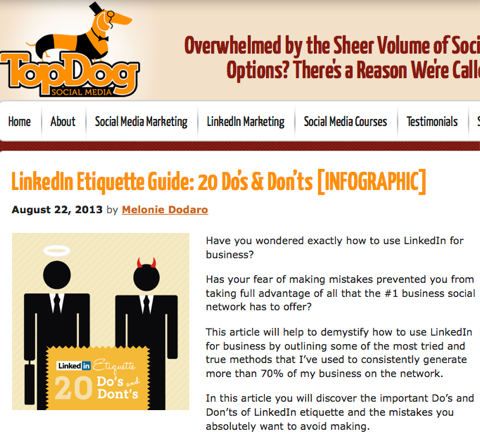
I love this article because I've put a lot of these tips into practice and have seen positive results. I've made some great contacts within the Pinterest marketing community through LinkedIn, and it's led to a lot of guest blogging opportunities and interesting discussions.
The tip that I like the most is about sending a LinkedIn welcome message that delivers value to your contacts. This can be a message that provides a link to your latest ebook or a report that's helpful to your LinkedIn connections.
Vincent Ng, president of MCNG Marketing and a Pinterest marketer.
#19: Facebook Marketing: From 2,500 to 1 Million Fans in Just Two Years

The most valuable social media blog post for me, published on the Crazy Egg blog, was called Facebook Marketing: From 2,500 to 1 Million Fans in Just Two Years.
Generally, this article taught me that social media marketing is not a sprint, but a calculated marathon. It's important to remember this if you are using social media for your business.
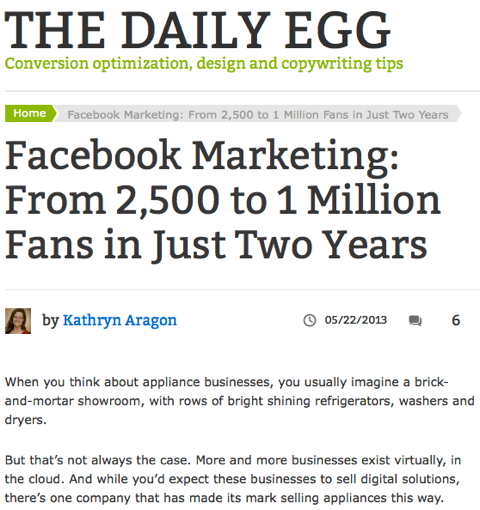
Specifically, there are three things that I really liked about this post:
- Grounded in reality: This post is based on a real case study of Appliances Online Co.
- Takes you behind the scenes: This post shows you things that aren't usually discussed about a successful social media operation.
- Relatable to most businesses: This article does a terrific job of highlighting the grassroots marketing strategies that most businesses can relate to and utilize to see truly efficient results.
Adeel Vanthaliwala, co-founder of Incentivibe.
#20: Breaking Down the Four Ms of Influence Marketing for Better ROI

The post that truly made me reevaluate my perspective about online influence is Danny Brown's Breaking Down the Four Ms of Influence Marketing for Better ROI.
After reading this post, I started to think about how I could shift from focusing on influencers as determined by Kred or Klout, which really just measures amplification. Instead, I started to focus on connecting with the real influencers: people who will motivate my customers along the sales funnel, ultimately to the purchase decision.
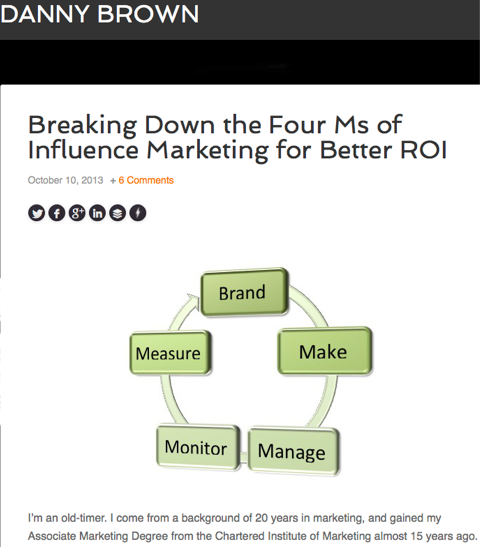
Kimberly Reynolds, co-founder of SocialNotz.
#21: A Scientific Guide to Writing Great Headlines on Twitter, Facebook and Your Blog

In 2013, this fabulous post from Leo Widrich at Buffer was the one that I referred back to the most.
Leo's post is packed with hot tips for getting more mileage out of your social media marketing. I love that it includes some really clever ways to structure your Twitter and Facebook headlines, not just on your blog.
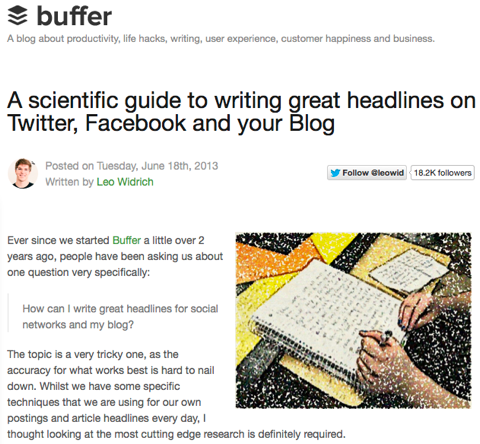
My key takeaways:
- Don't just post images, “post pictures that are meaningful without having to read any text next to it.“
- Test your blog post headlines first on Twitter and Facebook (Leo shows you how).
- Use language that makes your headlines “pop.” Leo lists the 20 most retweetable words—the words most likely to get traffic for your blog post—and makes a case for including numbers in your headlines (the bigger the better).
- The importance of writing how-to articles, which of course has been a key to the success of Social Media Examiner.
There are hundreds of blog posts that I read and love every year, but if you want to be successful on social media, do what I did: bookmark, refer to and apply some of the tips in this post in 2014.
Donna Moritz, founder of Socially Sorted.
#22: 32 Experts Share Their Best Blog Post Promotion Tips

One of my favorite social media blog posts in 2013 was 32 Experts Share Their Best Blog Post Promotion Tips from Kristi Hines at Kikolani.
In this post, Kristi gathers 32 best practices from the experts on the most effective ways to promote your blog content through social media and beyond. You will undoubtedly recognize many of the experts whom she asked to contribute to the post.
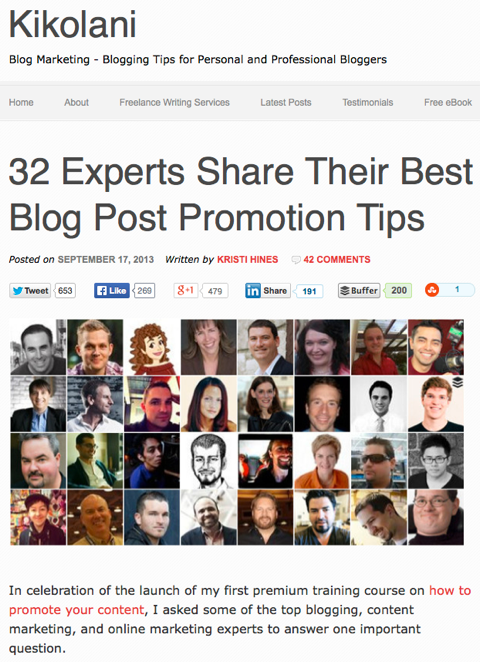
I really enjoyed reading the insights of these successful contributors and also picked up some great tips for my own blog promotion strategies!
Stephanie Sammons, founder of Build Online Influence.
#23: 51 Irresistible Social Media Tool and Technology Tips

Ian Cleary has done a terrific job taking his RazorSocial blog from zero to 100 miles per hour in just under 18 months.
He's done it by creating amazingly helpful blog posts like 51 Irresistible Social Media Tool and Technology Tips.
The post is classic Ian Cleary, packed with helpful information that is not only relevant but also actionable.
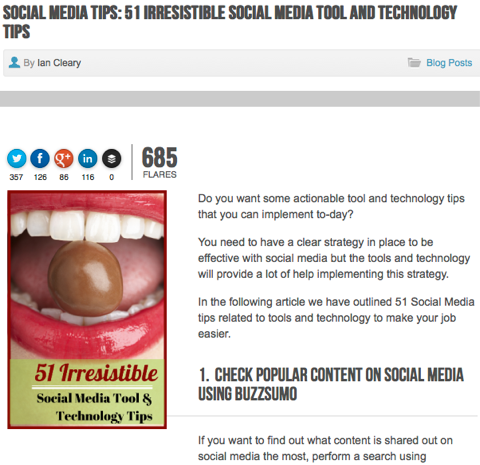
If you want to see how to take a blog from nothing to something in just a year and a half, and you want to learn valuable social media tips in the process, you can't go wrong with this blog post and Ian's blog.
Jamie Turner, founder of the 60 Second Marketer.
#24: 52 Unique Ways to Create Social Media Magic

I loved this post because it reviews a lot of the basics that we all should be doing, but it also gives some great insights into the nuances of specific platforms.
Too many blogs posts about social media don't dive into specific how-tos and I love Rebekah's easy-to-understand style for beginning or advanced social media marketers.
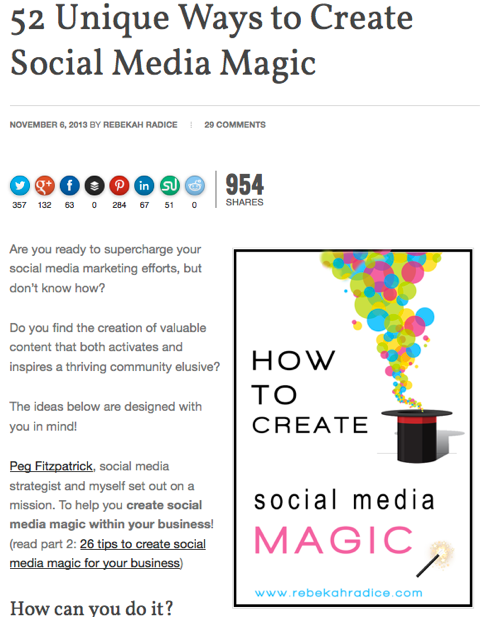
I especially like the tips for Pinterest and Google+ (two emerging platforms with enormous SEO opportunities). These are tips I'll be implementing immediately!
Katie Lance, CEO/owner of Katie Lance Consulting.
#25: Empowerment Marketing: Advertising to Humans as More Than Just Selfish Machines

I discovered Jonah Sachs this year while studying storytelling for my degree in Media Psychology. This blog post on Fast Company is an excerpt from his book, Winning the Story Wars, and outlines what he calls empowerment marketing.
It's a fresh take on how companies need to craft messages that empower consumers instead of making them feel inadequate. He reveals the tactics of the inadequacy approach and explains why they no longer work on social media–savvy consumers.
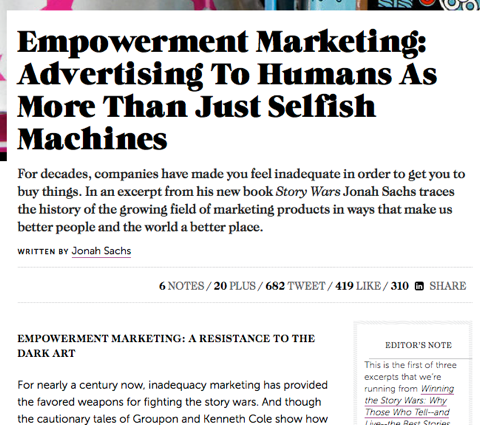
The article also lays out specific empowerment marketing tactics that social media strategists and community managers can use to connect with their audience. His tactics will help you inspire, motivate and reach the core values of your target audience. Each tactic outlined is supported with evidence from real campaigns from brands like Nike, Dove, Apple and Volkswagen.
Lisa Peyton, a leader in the field of digital marketing who serves as editor at ThoroughlyModernMarketing.com.
#26: Ten Visibility Tips for Google Plus

I loved this guest post and infographic by Stephan Hovnanian, Ten Visibility Tips for Google Plus, that he created in October for Denise Wakeman's site.
Stephan is one of the most helpful people I've found on G+, and this infographic succinctly sums up 10 tips for the platform.
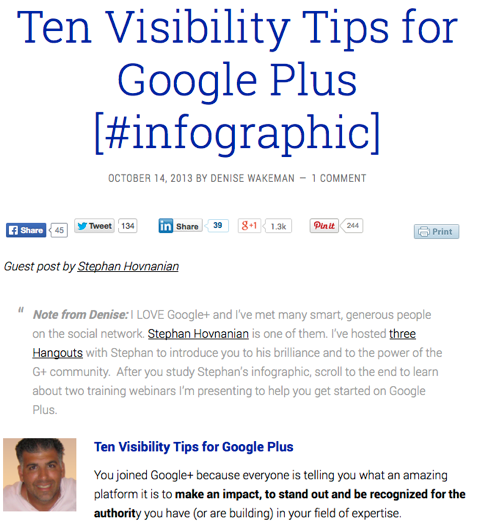
Since Google+ has some distinct features and cultural differences from the other social media outlets, I appreciated learning from a pro how to take advantage of them to get more engagement and boost visibility.
I particularly appreciated the tip about posting to communities vs. posting only to your profile. It's a great way to get some traction on your posts, particularly when you're just starting out on G+ and don't have many followers.
Louise Julig, Social Media Examiner's case study writer, freelance writer and former engineer.
#27: Taking the Long View: Social Media's Real ROI

When it comes to social media, many businesses simply want a clear ROI they can calculate. It's a topic that continues to occupy marketers who want to track every single dollar that their social media efforts have generated.
In this blog post, Ian Lurie explains why social media's ROI is actually all about the long-term, from great customer service through a company's social media channels to improving the overall opinion of your brand.
While these types of social media investments often lose money when measuring near-term ROI, Lurie's point is that these activities have big-time growth implications. Or as he puts it: “The long-term payoff is huge.”
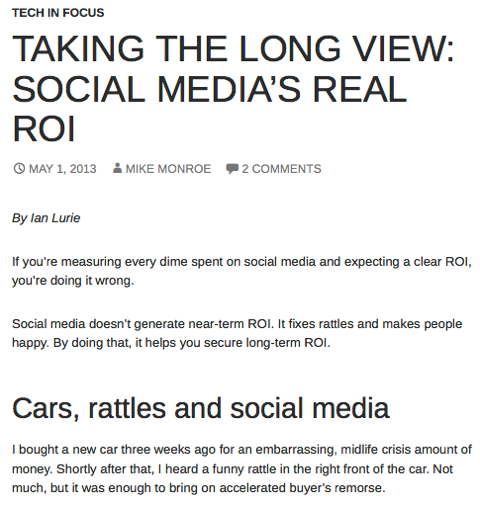
Bryden McGrath, social media coordinator at Precor Incorporated.
#28: How to Find More Content Ideas Than You'll Ever Be Able to Create

I love this post because it addresses one of the biggest challenges for businesses in regards to social strategy: content ideas.
Let's not forget that the blog is probably the most important and underutilized social media tool out there, and content is its fuel. Without a constant source of high-quality, original content, your overall social strategy will suffer.
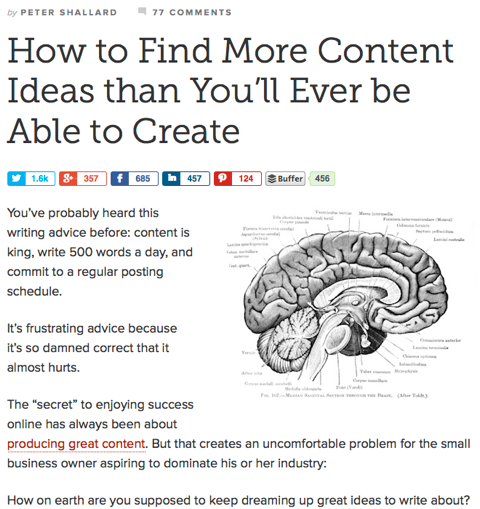
What I learned from this post is that many of us have far more to say than we probably ever realize and it's up to us to pull these ideas and topics out of the deep recesses of our unconscious minds.
Peter Shallard takes a deep dive into the psychology of content success and poses three questions to help content creators and social marketers dig deep and never run out ideas to write about.
Shallard also reminds us that the basics matter more than ever: “writing magnetic headlines, building irresistible narratives and focusing on good writing are still important.” But by continuing to ask yourself the three simple questions he proposes in the post, you'll get great ideas flowing and have “an unlimited source that you can craft into brilliance.”
Timeless advice for social media and content marketers alike.
Jason Miller, senior content marketing manager at LinkedIn.
#29: The Story Behind the Numbers: Social Media Research

Having read extensively on the subject in 2013, I loved the Internet Advertising Bureau's (IAB) research on proof of ROI for social. While those of us “in the biz” are of course aware that social is a powerful medium for businesses, it's not always simple to convince clients of this.
For me, the study gives a solid insight into social media ROI from a reputable source that could be worked on to give insight to clients and my readers. The idea that social can produce a return of 3:1 is valuable to businesses and can really help agencies communicate extra value to clients. It's easy to claim proven results, but sometimes business owners are naturally skeptical about such claims.
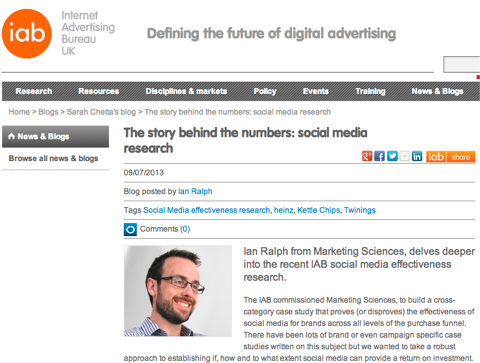
The study claimed that for every $1.64 spent on social, the return is $5.47 (converted from GBP to USD), which is a significant ROI.
Of course, not everyone agreed with the study. Bryan Urbick of the Consumer Knowledge Center pointed to a Pepsi campaign that suggested otherwise.
I really liked the research as it led to further research and allowed me to get a grip on understanding why the debate on the value of social remains. This also gave rise to a better understanding of how tools such as CRM can help.
Kerry Butters, founder and director of markITwrite.
#30: 46 Experts Share Their Top Social Media Management Tools

The single most valuable blog post I read on social media in 2013 was an article titled, 46 Experts Share Their Top Social Media Management Tools.
The reason I loved this article so much was because it emphasizes that while it's important to develop a social media strategy, you need to be able to execute on that strategy. Trying to squeeze 24 hours of work into an 8-hour day is nearly impossible unless you have the right tools to help do the job.
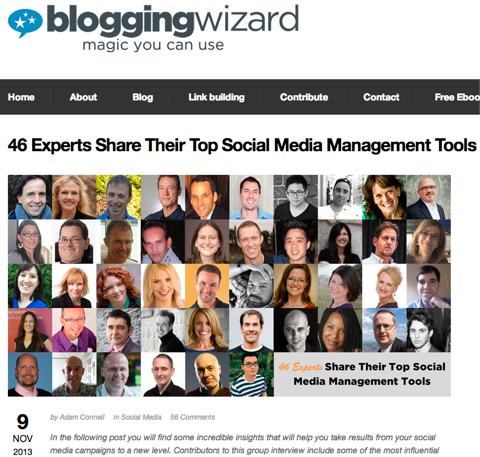
This article teaches about a lot of the social media tools that are available to help manage the day-to-day time spent on social media.
What I enjoyed most was learning about the different tools many of today's social media professionals are currently using and where those tools can be applied to help execute a successful social media strategy.
Christian Karasiewicz, founder of FB Marketing University.

#31: Blog Optimization: How to Optimize Your Blog
Unlike many social media marketers, Andy Crestodina can be geeky (in a good way).
In this post, Andy lifts the hood on Google Analytics to show bloggers how to get their posts to rank better. If it works for top bloggers like Gini Dietrich of Spin Sucks, it'll work for you.
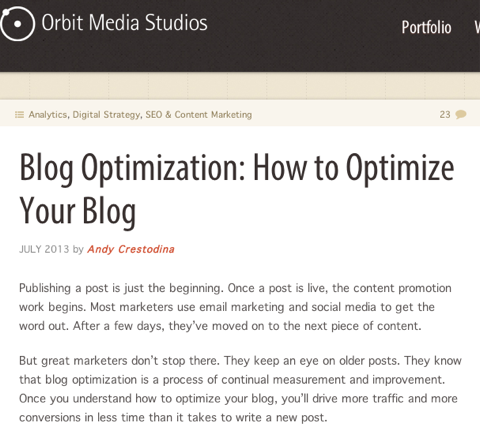
Heidi Cohen, chief content officer at HeidiCohen.com.
What do you think? Which one of these is your favorite? Please share your comments below.
Attention Agency Owners, Brand Marketers, and Consultants

Introducing the Marketing Agency Show–our newest podcast designed to explore the struggles of agency marketers.
Join show host and agency owner, Brooke Sellas, as she interviews agency marketers and digs deep into their biggest challenges. Explore topics like navigating rough economic times, leveraging AI, service diversification, client acquisition, and much more.
Just pull up your favorite podcast app, search for Marketing Agency Show and start listening. Or click the button below for more information.

